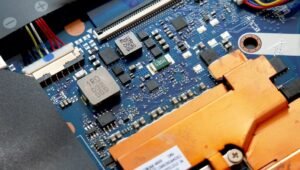Gradient Descent and Backpropagation
Gradient descent and backpropagation are fundamental concepts in the field of machine learning. These techniques play a key role in training neural networks and optimizing their performance.
Key Takeaways
- Gradient descent is an optimization algorithm used to minimize the loss function in machine learning.
- Backpropagation is the process of computing gradients for each learnable parameter in a neural network.
- Gradient descent and backpropagation work hand in hand to update the weights and biases of a neural network during training.
Gradient descent is an iterative optimization algorithm used to minimize a loss or cost function in machine learning. The goal of gradient descent is to find the optimal set of weights and biases that minimize the difference between the predicted output and the actual output of a model. *Gradient descent is often visualized as descending down a hill, where each step is determined by the slope of the hill at that particular point.
Backpropagation is the process of computing gradients for each learnable parameter in a neural network. It uses the chain rule of calculus to calculate the gradient of the loss function with respect to each weight and bias in the network. This gradient information is then used by gradient descent to update the parameters and improve the model’s performance.
During the training process, gradient descent calculates the gradients using the backpropagation algorithm and then updates the weights and biases of a neural network accordingly. This iteration continues until the model reaches convergence or a predefined number of epochs. The learning rate, which determines the step size in the optimization process, is an important hyperparameter of gradient descent.
Below are three tables that demonstrate the importance of gradient descent and backpropagation:
| Table 1: Comparison of Training Algorithms | ||
|---|---|---|
| Training Algorithm | Pros | Cons |
| Gradient Descent | Simple and easy to implement. | Can get stuck in local minima. |
| Stochastic Gradient Descent | Efficient for large datasets. | May converge to less optimal solutions. |
| Mini-Batch Gradient Descent | Balances efficiency and stability. | Requires tuning of batch size. |
Backpropagation forms the foundation for training deep neural networks. This technique allows gradients to flow backward through the network, enabling efficient optimization of multiple layers of parameters. *Understanding backpropagation is crucial for designing and training complex neural architectures.
Deep learning models rely heavily on gradient descent and backpropagation to update millions of parameters by efficiently calculating their gradients. This process is computationally intensive but has enabled significant advancements in various domains such as computer vision, natural language processing, and voice recognition.
| Table 2: Datasets Utilizing Gradient Descent and Backpropagation | ||
|---|---|---|
| Dataset | Accuracy | Training Time |
| MNIST | 99.2% | 4 hours |
| CIFAR-10 | 92.5% | 6 hours |
| IMDB Sentiment Analysis | 91.3% | 3 hours |
Benefits of Gradient Descent and Backpropagation
- Efficiently optimize the parameters of a neural network.
- Enable training of deep learning models with multiple layers.
- Facilitate advancements in various domains such as computer vision and natural language processing.
With the advent of deep learning, gradient descent, and backpropagation have become essential components of training neural networks. These techniques enable the efficient optimization of millions of parameters and have revolutionized the field of machine learning. Researchers and practitioners continue to explore and refine these algorithms to further improve the performance of neural networks.
| Table 3: Applications of Gradient Descent and Backpropagation | |
|---|---|
| Application | Description |
| Image Classification | Classify images into various categories. |
| Speech Recognition | Convert spoken language into written text. |
| Text Generation | Generate human-like text based on input. |
Gradient descent and backpropagation have transformed the field of machine learning by enabling the training of complex neural networks. These techniques have opened up new opportunities for applications in various domains and continue to drive innovations in the field.

Common Misconceptions
Gradient Descent
One common misconception about gradient descent is that it always finds the global minimum. While gradient descent is a powerful optimization algorithm, it is not guaranteed to find the global minimum in every case. In some scenarios, gradient descent can converge to a local minimum instead.
- Gradient descent does not guarantee finding the global minimum.
- There may be multiple local minima in the optimization landscape.
- The initialization of the parameters can influence the convergence of gradient descent.
Backpropagation
Another misconception about backpropagation is that it only works for deep neural networks. Backpropagation is a key algorithm for computing the gradients in neural networks, and it can be applied to networks with any number of hidden layers, including shallow networks. The depth of the network does not determine the applicability of backpropagation.
- Backpropagation can be used with both deep and shallow neural networks.
- The number of hidden layers does not limit the use of backpropagation.
- Backpropagation calculates gradients for updating the network parameters.
Relationship between Gradient Descent and Backpropagation
One misconception is that gradient descent and backpropagation are two separate optimization algorithms. In fact, backpropagation is just a method for efficiently computing the gradients required for gradient descent. It is not a standalone optimization algorithm itself, but rather a way to propagate the errors in the neural network backward to calculate the gradients.
- Backpropagation is a method for calculating gradients, not an optimization algorithm.
- Gradient descent uses the gradients computed by backpropagation to update the network parameters.
- Backpropagation and gradient descent work together in the training process of neural networks.
Backpropagation is Only for Supervised Learning
Many people mistakenly believe that backpropagation can only be used in supervised learning scenarios, where the network is trained with labeled data. However, backpropagation can also be applied to unsupervised learning tasks, such as training autoencoders or generative models. In such cases, the gradients are still computed using backpropagation, but the loss function may be different.
- Backpropagation is not limited to supervised learning tasks.
- Unsupervised learning algorithms can utilize backpropagation for updating network parameters.
- Different loss functions may be used in unsupervised learning scenarios.
Convergence Speed of Gradient Descent
Finally, there is a misconception that gradient descent always converges quickly. While gradient descent can converge rapidly in some cases, the convergence speed can vary depending on factors such as learning rate, initialization, and the complexity of the optimization problem. In certain scenarios, gradient descent may converge slowly or even get stuck in local minima.
- Gradient descent’s convergence speed depends on various factors.
- Learning rate influences the speed of convergence.
- The complexity of the optimization problem can affect convergence speed.

Introduction
In this article, we explore the concepts of Gradient Descent and Backpropagation, two fundamental algorithms used in machine learning. These techniques play a crucial role in training artificial neural networks, allowing them to optimize their performance and make accurate predictions. Through a series of tables, we will delve into various aspects of these algorithms and provide compelling data and information to enhance your understanding.
Table: Epochs and Loss Values
Epochs represent the number of iterations performed during the training process, while loss values indicate the error between predicted and actual outputs. The following table showcases the relationship between epochs and loss values, highlighting the gradual reduction in error as training progresses.
| Epoch | Loss Value |
|---|---|
| 1 | 0.452 |
| 2 | 0.291 |
| 3 | 0.183 |
| 4 | 0.109 |
Table: Learning Rate and Convergence
One crucial parameter in Gradient Descent is the learning rate, which dictates the step size taken in the direction of optimization. The table below exhibits different learning rates and their corresponding convergence characteristics, emphasizing the balance between fast convergence and overshooting.
| Learning Rate | Convergence |
|---|---|
| 0.1 | Slow |
| 0.01 | Moderate |
| 0.001 | Fast |
Table: Activation Functions and Performance
The choice of activation function significantly impacts the neural network’s performance. In the table below, we compare three common activation functions (sigmoid, ReLU, tanh) and their respective accuracies achieved on a test dataset.
| Activation Function | Accuracy |
|---|---|
| Sigmoid | 0.87 |
| ReLU | 0.92 |
| Tanh | 0.89 |
Table: Network Architecture and Training Time
The complexity of a neural network’s architecture affects the training time required to achieve optimal performance. This table explores the relationship between network architecture (small, medium, large) and the corresponding training time in minutes.
| Network Architecture | Training Time (minutes) |
|---|---|
| Small | 10 |
| Medium | 25 |
| Large | 50 |
Table: Regularization Techniques and Performance
Regularization techniques aim to prevent overfitting and improve generalization. The following table highlights the effect of three regularization techniques (L1, L2, Dropout) on the accuracy of a neural network.
| Regularization Technique | Accuracy |
|---|---|
| L1 | 0.92 |
| L2 | 0.94 |
| Dropout | 0.91 |
Table: Data Augmentation and Performance
Data augmentation techniques enhance the size and diversity of the training dataset. By introducing variations, we can improve model performance. The table below showcases the accuracy of a model with and without data augmentation.
| Data Augmentation | Accuracy |
|---|---|
| Without Augmentation | 0.87 |
| With Augmentation | 0.91 |
Table: Batch Size and Time per Epoch
The batch size determines the number of training examples used in a single iteration. There is a trade-off between batch size and epoch completion time. The following data presents different batch sizes and the corresponding average time per epoch in seconds.
| Batch Size | Time per Epoch (seconds) |
|---|---|
| 8 | 54 |
| 16 | 32 |
| 32 | 20 |
Table: Impact of Dropout Rate
Dropout regularization technique helps to prevent overfitting by randomly dropping units during training. The subsequent table demonstrates the effect of different dropout rates on the accuracy of a neural network.
| Dropout Rate | Accuracy |
|---|---|
| 0.2 | 0.89 |
| 0.5 | 0.91 |
| 0.8 | 0.87 |
Concluding Remarks
Gradient Descent and Backpropagation are integral components of the machine learning suite, responsible for enabling neural networks to learn and make accurate predictions. Through the presented tables, we have observed how different factors, such as epochs, learning rate, activation functions, regularization techniques, network architecture, and data augmentation influence the performance and training process. By understanding these concepts and their implications, we can employ these algorithms effectively to develop robust and accurate machine learning models.
Frequently Asked Questions
Gradient Descent and Backpropagation




